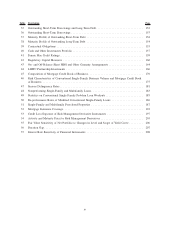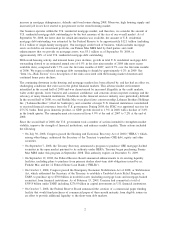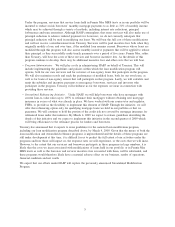Fannie Mae 2008 Annual Report Download - page 12
Download and view the complete annual report
Please find page 12 of the 2008 Fannie Mae annual report below. You can navigate through the pages in the report by either clicking on the pages listed below, or by using the keyword search tool below to find specific information within the annual report.-
 1
1 -
 2
2 -
 3
3 -
 4
4 -
 5
5 -
 6
6 -
 7
7 -
 8
8 -
 9
9 -
 10
10 -
 11
11 -
 12
12 -
 13
13 -
 14
14 -
 15
15 -
 16
16 -
 17
17 -
 18
18 -
 19
19 -
 20
20 -
 21
21 -
 22
22 -
 23
23 -
 24
24 -
 25
25 -
 26
26 -
 27
27 -
 28
28 -
 29
29 -
 30
30 -
 31
31 -
 32
32 -
 33
33 -
 34
34 -
 35
35 -
 36
36 -
 37
37 -
 38
38 -
 39
39 -
 40
40 -
 41
41 -
 42
42 -
 43
43 -
 44
44 -
 45
45 -
 46
46 -
 47
47 -
 48
48 -
 49
49 -
 50
50 -
 51
51 -
 52
52 -
 53
53 -
 54
54 -
 55
55 -
 56
56 -
 57
57 -
 58
58 -
 59
59 -
 60
60 -
 61
61 -
 62
62 -
 63
63 -
 64
64 -
 65
65 -
 66
66 -
 67
67 -
 68
68 -
 69
69 -
 70
70 -
 71
71 -
 72
72 -
 73
73 -
 74
74 -
 75
75 -
 76
76 -
 77
77 -
 78
78 -
 79
79 -
 80
80 -
 81
81 -
 82
82 -
 83
83 -
 84
84 -
 85
85 -
 86
86 -
 87
87 -
 88
88 -
 89
89 -
 90
90 -
 91
91 -
 92
92 -
 93
93 -
 94
94 -
 95
95 -
 96
96 -
 97
97 -
 98
98 -
 99
99 -
 100
100 -
 101
101 -
 102
102 -
 103
103 -
 104
104 -
 105
105 -
 106
106 -
 107
107 -
 108
108 -
 109
109 -
 110
110 -
 111
111 -
 112
112 -
 113
113 -
 114
114 -
 115
115 -
 116
116 -
 117
117 -
 118
118 -
 119
119 -
 120
120 -
 121
121 -
 122
122 -
 123
123 -
 124
124 -
 125
125 -
 126
126 -
 127
127 -
 128
128 -
 129
129 -
 130
130 -
 131
131 -
 132
132 -
 133
133 -
 134
134 -
 135
135 -
 136
136 -
 137
137 -
 138
138 -
 139
139 -
 140
140 -
 141
141 -
 142
142 -
 143
143 -
 144
144 -
 145
145 -
 146
146 -
 147
147 -
 148
148 -
 149
149 -
 150
150 -
 151
151 -
 152
152 -
 153
153 -
 154
154 -
 155
155 -
 156
156 -
 157
157 -
 158
158 -
 159
159 -
 160
160 -
 161
161 -
 162
162 -
 163
163 -
 164
164 -
 165
165 -
 166
166 -
 167
167 -
 168
168 -
 169
169 -
 170
170 -
 171
171 -
 172
172 -
 173
173 -
 174
174 -
 175
175 -
 176
176 -
 177
177 -
 178
178 -
 179
179 -
 180
180 -
 181
181 -
 182
182 -
 183
183 -
 184
184 -
 185
185 -
 186
186 -
 187
187 -
 188
188 -
 189
189 -
 190
190 -
 191
191 -
 192
192 -
 193
193 -
 194
194 -
 195
195 -
 196
196 -
 197
197 -
 198
198 -
 199
199 -
 200
200 -
 201
201 -
 202
202 -
 203
203 -
 204
204 -
 205
205 -
 206
206 -
 207
207 -
 208
208 -
 209
209 -
 210
210 -
 211
211 -
 212
212 -
 213
213 -
 214
214 -
 215
215 -
 216
216 -
 217
217 -
 218
218 -
 219
219 -
 220
220 -
 221
221 -
 222
222 -
 223
223 -
 224
224 -
 225
225 -
 226
226 -
 227
227 -
 228
228 -
 229
229 -
 230
230 -
 231
231 -
 232
232 -
 233
233 -
 234
234 -
 235
235 -
 236
236 -
 237
237 -
 238
238 -
 239
239 -
 240
240 -
 241
241 -
 242
242 -
 243
243 -
 244
244 -
 245
245 -
 246
246 -
 247
247 -
 248
248 -
 249
249 -
 250
250 -
 251
251 -
 252
252 -
 253
253 -
 254
254 -
 255
255 -
 256
256 -
 257
257 -
 258
258 -
 259
259 -
 260
260 -
 261
261 -
 262
262 -
 263
263 -
 264
264 -
 265
265 -
 266
266 -
 267
267 -
 268
268 -
 269
269 -
 270
270 -
 271
271 -
 272
272 -
 273
273 -
 274
274 -
 275
275 -
 276
276 -
 277
277 -
 278
278 -
 279
279 -
 280
280 -
 281
281 -
 282
282 -
 283
283 -
 284
284 -
 285
285 -
 286
286 -
 287
287 -
 288
288 -
 289
289 -
 290
290 -
 291
291 -
 292
292 -
 293
293 -
 294
294 -
 295
295 -
 296
296 -
 297
297 -
 298
298 -
 299
299 -
 300
300 -
 301
301 -
 302
302 -
 303
303 -
 304
304 -
 305
305 -
 306
306 -
 307
307 -
 308
308 -
 309
309 -
 310
310 -
 311
311 -
 312
312 -
 313
313 -
 314
314 -
 315
315 -
 316
316 -
 317
317 -
 318
318 -
 319
319 -
 320
320 -
 321
321 -
 322
322 -
 323
323 -
 324
324 -
 325
325 -
 326
326 -
 327
327 -
 328
328 -
 329
329 -
 330
330 -
 331
331 -
 332
332 -
 333
333 -
 334
334 -
 335
335 -
 336
336 -
 337
337 -
 338
338 -
 339
339 -
 340
340 -
 341
341 -
 342
342 -
 343
343 -
 344
344 -
 345
345 -
 346
346 -
 347
347 -
 348
348 -
 349
349 -
 350
350 -
 351
351 -
 352
352 -
 353
353 -
 354
354 -
 355
355 -
 356
356 -
 357
357 -
 358
358 -
 359
359 -
 360
360 -
 361
361 -
 362
362 -
 363
363 -
 364
364 -
 365
365 -
 366
366 -
 367
367 -
 368
368 -
 369
369 -
 370
370 -
 371
371 -
 372
372 -
 373
373 -
 374
374 -
 375
375 -
 376
376 -
 377
377 -
 378
378 -
 379
379 -
 380
380 -
 381
381 -
 382
382 -
 383
383 -
 384
384 -
 385
385 -
 386
386 -
 387
387 -
 388
388 -
 389
389 -
 390
390 -
 391
391 -
 392
392 -
 393
393 -
 394
394 -
 395
395 -
 396
396 -
 397
397 -
 398
398 -
 399
399 -
 400
400 -
 401
401 -
 402
402 -
 403
403 -
 404
404 -
 405
405 -
 406
406 -
 407
407 -
 408
408 -
 409
409 -
 410
410 -
 411
411 -
 412
412 -
 413
413 -
 414
414 -
 415
415 -
 416
416 -
 417
417 -
 418
418
 |
 |
many of these efforts are relatively new and are being applied more broadly and in ways that we have not
previously applied them. As a result, it will take time for us to assess and provide statistical information both on
the relative success of these efforts and their effect on our results of operations and financial condition. Our early
experience indicates that a number of our programs may not be achieving results either as rapidly as we had
expected or in the ways that we had expected, and we are working with our conservator to reassess these
programs in order to both help us best fulfill our objective of helping homeowners and the mortgage market, and
to determine their effectiveness and priority with respect to the recently announced HASP. As we assess these
programs, we may expand, eliminate or modify these programs in the future. We have included data relating to
our borrower loss mitigation activities for 2008 and prior periods in “Part II—Item 7—Risk Management—
Credit Risk Management—Mortgage Credit Risk Management.”
Because approximately 92% of our guaranty book of business is made up of single-family conventional
mortgage loans that we own or that are in guaranteed Fannie Mae MBS and because the number of seriously
delinquent loans is significantly higher for our single-family mortgage credit guaranty book, we have focused
our credit loss reduction and foreclosure prevention efforts primarily on these single-family conventional
loans. The recently announced HASP is consistent with that focus. We have developed a variety of options for
providing assistance, rather than relying on a “one size fits all” approach, in recognition that no single solution
will resolve the varied problems facing homeowners who currently need assistance or who may need
assistance in the future. As we implement these new initiatives, however, we face a variety of challenges that
have limited the early success of our initiatives.
One challenge we face is the current unpredictability of consumer behavior. As a result, in introducing new
programs, we have little historical data that we can use either as a basis for predicting consumer impact,
response and acceptance rates, or to identify consumer behavior that is not consistent with historical patterns.
To address this challenge, we monitor and assess on a regular basis both our workout initiatives and our
understanding of borrowers’ needs in the current market environment so that we will be in a position to offer
solutions designed to have the highest possible success rate.
A second challenge we face is the stress that the current market environment has placed on servicer resources.
Because we implement all of our homeowner assistance programs through servicers and depend on them to
implement our initiatives effectively, limitations on servicer capacity and capabilities can significantly limit
both the success of our initiatives and the amount of flexibility that can be offered within and among various
initiatives. We therefore are focusing our efforts on accommodating servicers’ resource constraints by creating
and offering streamlined solutions for borrowers that are relatively easy both to explain and to implement. We
also have increased the number of our own personnel that we place onsite in the offices of our largest
servicers in order to enhance the servicers’ capacity in the face of their increasingly heavy workload.
Third, we are experiencing challenges in creating initiatives that will permit homeowners who face debt
pressure from a variety of sources in addition to mortgage loan payments to manage all of their debt payments
successfully. Other types of consumer debt and obligations arise from a variety of sources, including second
mortgages, credit card debt, loans to purchase an automobile, property insurance, and real estate taxes.
Because we generally only have the ability to affect a homeowner’s obligations relating to his or her first lien
mortgage loan, we expect that, in many cases, we may not be able to offer sufficient assistance to permit the
homeowner to continue to meet all existing obligations.
Finally, we believe that, during the current crisis, one of the key elements for successfully assisting
homeowners and preventing foreclosures is to reach troubled and potentially troubled borrowers earlier in the
delinquency process. We are working to develop effective ways to achieve this earlier intervention, which we
believe is necessary to accelerate positive change in the current mortgage market.
Before the modification of a loan that is held in an MBS trust becomes effective, we generally purchase the
loan from the trust. When we do, we are required by generally accepted accounting principles (“GAAP”) to
record the loan on our consolidated balance sheet at its current market value, rather than the loan amount, and
recognize a loss for any difference between the loan amount and the market value of the loan. As we work
aggressively to assist homeowners and implement the loan modification provisions of HASP, we expect that
the number of loans we modify will increase substantially during 2009 and beyond. Some portion of the loans
7
